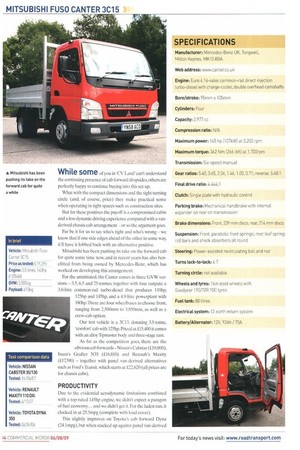White some of you in 'CV Land' can't understand the
Page 34

Page 35

Page 36

If you've noticed an error in this article please click here to report it so we can fix it.
continuing presence of cab forward dropsides, others are perfectly happy to continue buying into this set-up.
What with the compact dimensions and the tight turning circle (and, of course, price) they make practical sense when operating in tight spaces such as construction sites.
But for these positives the payoff is a compromised cabin and a less dynamic driving experience compared with a vanderived chassis cab arrangement or so the argument goes Far be it for us to say who's right and who's wrong — we know that if one side edges ahead of the other in some way, it'll have it lobbed back with an alternative positive.
Mitsubishi has been pushing its take on the forward cab for quite some time no and in recent years has also benefitted from being owned by Mercedes-Benz, which has worked on developing this arrangement.
For the uninitiated, the Canter comes in three GVW versions — 3.5,6.5 and 7.5-tonnes, together with four outputs: a 3.0-litre common-rail turbo-diesel that produces 110hp, 125hp and 145hp, and a 4.9-litre powerplant with 180hp.There are four wheelbases to choose from, ranging from 2,500mm to 3,850min, as well as a crew-cab option.
Our test vehicle is a 3C13, donating 3.5-tonne, 'comfort' cab with 125hp. Priced at £ L5,400 it comes with an alloy Tipmaster body and three-stage ram. As far as the competition goes, there are the obvious cab forwards —Nissan's Cabstar (£19.000), Isuzu's Grafter N35 (£16,810) and Renault's Maxity (£17,390) — together with panel van-derived alternatives such as Ford's Transit, which starts at £22,620 (all prices arc for chassis cabs).
PRODUCTIVITY
Due to the evidential aerodynamic limitations combined with a top-rated 145hp engine, we didn't expect a paragon of fuel economy... and we didn't get it. For the laden run, it clocked in at 25.5mpg (complete with load cover).
This slightly improves on Toyota's cab forward Dyna (24.1mpg), but when stacked up against panel van-derived
dropsidcs such as Renault's Trafic (30.5mpg) and Volkswagen's Transporter (32.6mpg), it loses some ground. If you are involved in regular motorway work, that's some serious food for thought.
The Canter's alloy body comes from Tipmaster and adds a keen f3.995 to the list price, as well as dropping payload down to 1,060kg from the chassis-cab's 1,5101(g. Its construction and execution is a typically solid affair, something we've come to expect from the Essex-based bodybuilder.
The whole unit is made from aluminium, with the side panels boasting an anodised finish, together with recessed release handles, which include a handy button that clicks them loose from their housing when pressed.
The tipping gear is a hcavy-duty three-stage ram affair, with simple to operate controls housed in the cabin, coming complete with a 'wander' lead. It also features a tipper raised warning bleeper and galvanised protective grill at the front along with a side access step. CAB COMFORT
Forward cab manufacturers are always at pains to eulogise about their cabs and how much space and practicality there is an admission of guilt perhaps? Because whichever way you look at it the driving position will be compromised due to the cab's positioning, which has you sitting upright over the front axle with the steering wheel in your lap.
In the Canter's case, it makes a fairly good fist of reducing this issue thanks to tight packaging, but access is not a smooth operation, particularly for taller drivers.
Yes, if you use the grab handle and step in co-ordination you can slide in gracefully enough, hut long legs have to be manoeuvred with caution.
Once seated there's enough rear seat travel and footwell space to please, particularly relevant for those with muddy boots, and this is complemented by an adjustable steering wheel.
The rest of the layout is simple and effective in design with easy to read dials and well-positioned storage there's a tray between the driver and passenger seats that works well, along with a fold-down middle back rest that incorporates a clipboard when dropped.
There are also several small gloveboxes and overhead parcel shelves, giving the Canter's interior a practical edge.
Praise also goes to the generous crosscab access, allowing the driver to hop out the passenger side without difficulty, and allows the middle passenger to travel in relative comfort.
On the move there's the typical under seat engine noise, but vibration is contained well enough, with induction roar kept at bay until you hit the high (3,500) revs.
However, at motorway speeds wind makes its presence felt, whipping around the A-pillar with enthusiasm. drive, displaying no adverse characteristies that can be associated with such machinery.
Its stiff chassis construction helps compensate for the soft suspension, which combine well on uneven surfaces such as building sites and the like, where it absorbs bumps with ease, though you do suffer from a degree of rebound as the cabin travels upwards.
This feature doesn't endear when it comes to cornering, making it feel ponderous. However, the Canter is safe enough, behaving sufficiently securely at normal speeds, aided by tight and accurate steering that helps to position it precisely.
The drive-train, with its high output, makes for easy acceleration; with a nice dollop of torque building progressively up to the 3,750rpm redline.
It is also fairly smooth for a low revving engine that's positioned under your posterior, and allows you to pull confidently up hills and gradients.
But we're less enthused by the gearshift, which is far too notchy for our liking, requiring patience when working through the cogs. As it has a dog-leg first gear set-up we found taking off in second far more appealing in order to avoid that rapid switch up, while the reverse gear deterrent wasn't strong enough and had the traffic behind panicking once or twice as the rear lights flashed on. •




































































































































